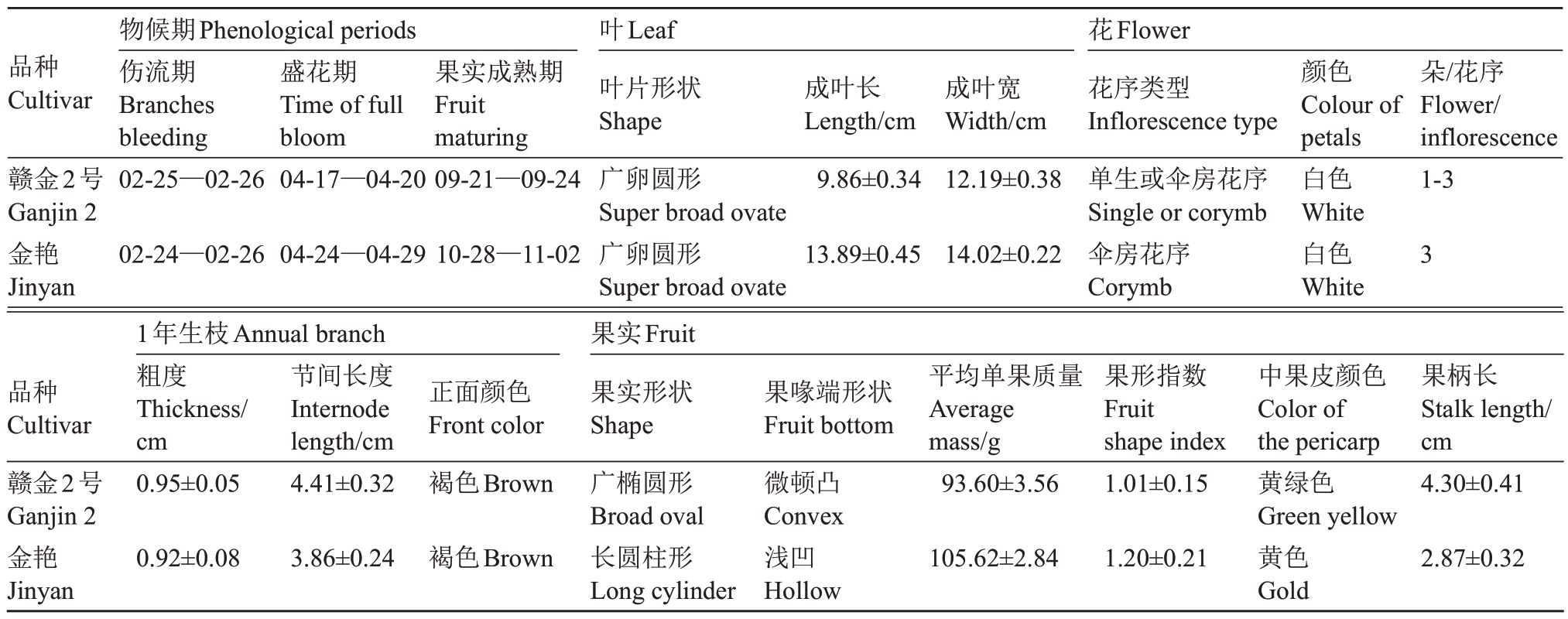猕猴桃(Actinidia)是原产于中国且极具特色的浆果,因其果实富含抗坏血酸、膳食纤维及多种矿物质元素,深受消费者喜爱。其中,中华猕猴桃(A.chinensis)是猕猴桃属栽培较为广泛的一个种,绝大部分品种为早熟(8月下旬至9月上旬)、晚熟(10月中下旬至11月上旬)品种,中熟(9月中旬至10月上旬)品种较少,导致果实采收期过于集中、果品供应期偏短,这严重制约中华猕猴桃种质资源的高效开发[1-3]。同时中华猕猴桃多以伞房花序为主,需要进行人工疏花、疏果以促进果实的正常生长发育,极大地增加了劳动成本。因此,中熟、单花结果是中华猕猴桃品种选育的重要目标性状。江西省具有丰富的野生猕猴桃种质资源,从中选育的金丰、魁蜜等品种已成为国内外猕猴桃的主要骨干亲本,这均为选育一个极具特色的早中熟中华猕猴桃品种奠定了良好基础。
1 选育过程
江西农业大学猕猴桃科研团队从2008年开始对江西省野生猕猴桃种质资源进行搜集和保存,其中在江西省抚州市宜黄县海拔548 m处发现了编号为YH-2的单株,该单株结果时为单花结果类型,且成熟期较早。从母树采集接穗,进行异位高接(砧木为美味猕猴桃米良1号)。2010年,在江西省奉新县山维猕猴桃科技开发有限公司资源圃进行了为期3 a(年)的性状观测,包括倍性、遗传稳定性、植物学特征、果实品质等。2014—2017年,采集其接穗在赣南、赣中均进行高接换种,以中华猕猴桃金艳[4]为对照,进行品种比较试验。多年的品种比较试验结果表明,该优株倍性、单花结果特性等植物学特征稳定遗传,果实均匀一致,成熟期在9月中下旬(奉新地区)。2019年,该优株被定名为赣金2号,并于2023年9月获得农业农村部植物新品种权(编号:CNA20201000528)。
2 主要特征特性
2.1 倍性鉴定
采集金果(二倍体)、金艳(四倍体)、金魁(六倍体)以及赣金2号的嫩叶进行倍性检测。测定结果表明,赣金2号与金艳一样均为稳定的四倍体植株(图1)。

图1 倍性检测结果
Fig.1 The result of ploidy tested
2.2 植物学特征
新梢表面有短茸毛;1年生枝呈黄褐色,平均节间长4.41 cm,直径0.95 cm,皮孔多呈长梭形,数量较多,黄色;结果母枝褐色,平均节间长2.36 cm,直径0.81 cm。幼叶和叶柄正面均有花青素着色,幼叶尖端渐尖,基部相接;成叶广卵圆形,叶尖平或微凹,叶长9.86 cm,叶宽12.19 cm,叶柄长6.11 cm,正面深绿色无茸毛,叶脉明显;花单生或伞房花序,每花序1~3朵花,花瓣为白色,5~7片(表1)。
表1 赣金2 号和金艳的植物学性状特性比较
Table 1 Comparison of fruit characteristics of Ganjin 2 and Jinyan

品种Cultivar赣金2号Ganjin 2金艳Jinyan物候期Phenological periods伤流期Branches bleeding 02-25—02-26盛花期Time of full bloom 04-17—04-20果实成熟期Fruit maturing 09-21—09-24成叶长Length/cm 9.86±0.34成叶宽Width/cm 12.19±0.38朵/花序Flower/inflorescence 1-3 02-24—02-26 04-24—04-29 10-28—11-02叶Leaf叶片形状Shape广卵圆形Super broad ovate广卵圆形Super broad ovate 13.89±0.45 14.02±0.22花Flower花序类型Inflorescence type单生或伞房花序Single or corymb伞房花序Corymb颜色Colour of petals白色White白色White 3品种Cultivar赣金2号Ganjin 2金艳Jinyan 1年生枝Annual branch粗度Thickness/cm 0.95±0.05节间长度Internode length/cm 4.41±0.32正面颜色Front color褐色Brown平均单果质量Average mass/g 93.60±3.56果形指数Fruit shape index 1.01±0.15果柄长Stalk length/cm 4.30±0.41 0.92±0.08 3.86±0.24褐色Brown果实Fruit果实形状Shape广椭圆形Broad oval长圆柱形Long cylinder果喙端形状Fruit bottom微顿凸Convex浅凹Hollow 105.62±2.84 1.20±0.21中果皮颜色Color of the pericarp黄绿色Green yellow黄色Gold 2.87±0.32
2.3 果实经济性状
果实广椭圆形(图2),单花结果率超过95%;果实纵径4.30 cm,横径4.25 cm,果形指数1.01;果喙微顿凸,果柄长4.30 cm;平均单果质量93.60 g,最大单果质量127.80 g;果皮褐色,均匀覆有中等偏少的黄色短茸毛,萼片有宿存;果肉黄绿色,髓射线明显,肉质细腻,味甜,有香气,风味浓郁,品质上等;果实可溶性固形物含量(w,后同)为19.20%,干物质含量为18.77%,可滴定酸含量为0.98%,抗坏血酸含量为1.88 mg·g-(1表2),果实耐贮藏,常温下可贮藏30~45 d。
表2 赣金2 号和金艳的果实特性比较
Table 2 Comparison of fruit characteristics of Ganjin 2 and Jinyan

品种Cultivar赣金2号Ganjin 2金艳Jinyan w(抗坏血酸)Ascorbic acid content/(mg·g-1)1.88±0.21 0.63±0.12 w(可溶性固形物)Soluble solids content/%19.20±0.51 15.38±0.32 w(干物质)Dry matter content/%18.77±0.41 13.86±0.22 w(总酸)Total acids content/%0.98±0.05 1.19±0.04

图2 中华猕猴桃新品种赣金2 号
Fig.2 A new A.chinensis cultivar Ganjin 2
2.4 生长结果习性与物候期
坐果率超过95%,落花落果少。在江西省奉新地区,盛花期在4 月中旬,花期为5~8 d,奉雄2 号可以作为配套的授粉雄株;果实发育期155~160 d,果实成熟期在9 月中下旬,为早中熟猕猴桃品种。连续结果能力强,结果枝率高(91.5%),正常生长的营养枝均可成为翌年的结果母枝(表1)。盛果期产量为28.50 t·hm-2。
2.5 DNA指纹图谱鉴定
利用4 对SSR分子标记,对赣金2号与已报道的中华猕猴桃品种金艳、金果及庐山香等进行鉴定,并构建分子身份证。结果表明,赣金2号与已报道的中华猕猴桃品种在DNA水平上存在显著差异(表3)。
表3 基于SSR 分子标记的分子身份证
Table 3 Molecular ID cards based on SSR molecular markers

品种(系)Cultivars赣金2号Ganjin 2金艳Jinyan金果Jinguo庐山香Lushanxiang武植3号Wuzhi 3早鲜Zaoxian魁蜜Kuimi翠玉Cuiyu华优Huayou金桃Jintao UDK96-035 1100010 1001010 0000001 0000000 1010010 1001010 0000000 0010000 1001110 1000010 FOR-13 100111111 111001100 000000000 000000100 011000100 010010101 000000000 110001100 110001100 001100101 EST-Ad42 0000111100 0000101000 0000100000 0000101000 1000111100 0011111001 0000111000 1001110100 0011110011 0000010100 UDK96-040 0000000010101010 0000011111011010 0000000011101010 0000010111101100 0000011000111000 0110000001100101 0000000000000000 1000011111110000 0000011111000000 0000001100001000
3 栽培技术要点
适宜在江西、湖南、浙江及纬度相似的省份种植,无霜期要求在150 d 以上,≥10 ℃的积温在1800 ℃以上。宜采用架式为水平大棚架,株行距(3.0~3.5)m×(4~5)m,树形为单干双主蔓多侧蔓式。进入盛果期的果园需要每年施2~3 次肥,春施N肥和复合肥分别用于壮芽、壮果,秋施基肥以有机肥为主。花期需要及时疏除弱花、晚花;由于其侧花坐果后会自动凋落,侧花可以不疏;奉雄2号可以作为配套的授粉雄株;坐果后及时疏除小果、畸形果、病虫果。当果实可溶性固形物含量达7.5%时(9 月中下旬)及时采收,去除地热后放入冷库贮藏。冬剪时,芽饱满且枝条粗壮的结果母蔓留7~8个有效芽,枝条稍微纤弱的结果母蔓则留5~6 个有效芽,太弱的结果母蔓直接疏除。
[1] 方金豹,钟彩虹.新中国果树科学研究70 年:猕猴桃[J].果树学报,2019,36(10):1352-1359.FANG Jinbao,ZHONG Caihong. Fruit scientific research in new China in the past 70 years:Kiwifruit[J]. Journal of Fruit Science,2019,36(10):1352-1359.
[2] 吕正鑫,贺艳群,贾东峰,黄春辉,钟敏,廖光联,朱壹,袁开昌,刘传浩,徐小彪. 猕猴桃种质资源表型性状遗传多样性分析[J].园艺学报,2022,49(7):1571-1581.LÜ Zhengxin,HE Yanqun,JIA Dongfeng,HUANG Chunhui,ZHONG Min,LIAO Guanglian,ZHU Yi,YUAN Kaichang,LIU Chuanhao,XU Xiaobiao. Genetic diversity analysis of phenotypic traits for kiwifruit germplasm resources[J]. Acta Horticulturae Sinica,2022,49(7):1571-1581.
[3] 吕正鑫,王海令,贺艳群,刘青,黄春辉,贾东峰,徐小彪.基于HS-SPME-GC-MS 的5 份猕猴桃种质风味品质研究[J].果树学报,2022,39(1):47-59.LÜ Zhengxin,WANG Hailing,HE Yanqun,LIU Qing,HUANG Chunhui,JIA Dongfeng,XU Xiaobiao. Flavor quality analysis of five kiwifruit germplasm based on HS-SPMEGC-MS[J].Journal of Fruit Science,2022,39(1):47-59.
[4] 钟彩虹,张鹏,韩飞,李大卫.猕猴桃种间杂交新品种‘金艳’的果实发育特征[J].果树学报,2015,32(6):1152-1160.ZHONG Caihong,ZHANG Peng,HAN Fei,LI Dawei. Studies on characterization of fruit development of interspecific hybrid cultivar‘Jinyan’[J].Journal of Fruit Science,2015,32(6):1152-1160.